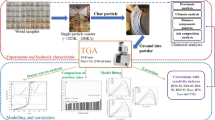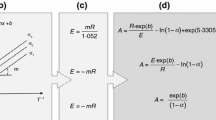Abstract
In order to determine the intrinsic reactivity behavior from thermogravimetry studies, the experimental conditions should be such that the reactions are not mass transfer limited. Biomass char usually has a higher reactivity than coal chars. Therefore, mass transfer limitations may be more problematic when studying biomass char reactivity. Chemical reaction kinetics and mass transfer processes present in thermogravimetry are used for modeling the overall reaction rate for spruce bark CO2 gasification. Thermogravimetric experiments are carried out between 700 and 900 °C, and the CO2 concentration is varied between 10 and 90 vol%. The intrinsic activation energy is found to be 120 kJ mol−1. The transition temperature between regimes I and II is here defined when the fraction apparent to true activation energy equals 0.75. Higher external mass transfer (e.g., by decreasing the diffusion path through the crucible’s freeboard), decreasing the sample amounts, and higher CO2 partial pressures for the Langmuir–Hinshelwood reaction type increase the transition temperature. The results show that the transition temperature between regimes I and II conditions is approx. 1,030 °C for 90 vol% CO2.










Similar content being viewed by others
Abbreviations
- A :
-
Pre-exponential factor (s−1)
- c :
-
Concentration (mol m−3)
- d :
-
Diameter (m)
- D :
-
Diffusion coefficient (m2 s−1)
- E :
-
Activation energy (J mol−1)
- h :
-
Height (m)
- J :
-
Flow (mol s−1)
- k :
-
Reaction rate constant, first-order reaction (s−1)
- k 1 :
-
Reaction rate constant, Langmuir–Hinshelwood mechanism (s−1)
- k 2, k 3 :
-
Constant, Langmuir–Hinshelwood mechanism (m3 mol−1)
- m :
-
Mass (kg)
- M :
-
Molar mass (g mol−1)
- N :
-
Number
- p :
-
Pressure (Pa, bar)
- r :
-
Radius (r = 0,…,R) (m)
- R :
-
Radius (R = d P/2) (m)
- Re :
-
Reynolds number (=ud/v)
- \( \mathcal{R} \) :
-
Universal gas constant (J mol−1 K−1)
- S :
-
Surface (=d 2π) (m 2)
- Sc :
-
Schmidt number (=ν/D)
- Sh :
-
Sherwood number (=βd/D)
- t :
-
Time (s, min)
- T :
-
Temperature (K, °C)
- v :
-
Diffusion volume
- X :
-
Conversion
- β:
-
Mass transfer coefficient (m s−1)
- γ:
-
Abbreviation Eq. (23) (m)
- δ:
-
Abbreviation Eq. (25) (m3 s−1)
- ε:
-
Porosity
- ν:
-
Kinematic viscosity (m2 s−1)
- φ:
-
Abbreviation Eq. (27) (m−1)
- ρ:
-
Density (kg m−3)
- ϱ:
-
Reaction rate (mol m−3 s−1)
- τ:
-
Tortuosity
- a:
-
Ash
- A:
-
True (activation energy)
- app:
-
Apparent
- B:
-
Bed
- c:
-
Char (including ash)
- F:
-
Freeboard
- i :
-
Counting index
- P:
-
Particle
- T:
-
Free flow in thermogravimetric device
References
Link S, Arvelakis S, Hupa M, Yrjas P, Kuelaots I, Paist A. Reactivity of the biomass chars originating from reed, Douglas fir, and pine. Energy Fuel. 2010;24:6533–9.
Yuan S, Chen XL, Li J, Wang FC. CO2 gasification kinetics of biomass char derived from high-temperature rapid pyrolysis. Energy Fuel. 2011;25:2314–21.
Mani T, Mahinpey N, Murugan P. Reaction kinetics and mass transfer studies of biomass char gasification with CO2. Chem Eng Sci. 2011;66:36–41.
Nowicki L, Antecka A, Bedyk T, Stolarek P, Ledakowicz S. The kinetics of gasification of char derived from sewage sludge. J Therm Anal Calorim. 2011;104:693–700.
Ollero P, Serrera A, Arjona R, Alcantarilla S. The CO2 gasification kinetics of olive residue. Biomass Bioenerg. 2003;24:151–61.
Ahmed II, Gupta AK. Kinetics of woodchips char gasification with steam and carbon dioxide. Appl Energy. 2011;88:1613–9.
Seo DK, Lee SK, Kang MW, Hwang J, Yu TU. Gasification reactivity of biomass chars with CO2. Biomass Bioenergy. 2010;34:1946–53.
Fermoso J, Stevanov C, Moghtaderi B, Arias B, Pevida C, Plaza MG, Rubiera F, Pis JJ. High-pressure gasification reactivity of biomass chars produced at different temperatures. J Anal Appl Pyrol. 2009;85:287–93.
Szekely J, Evans JW, Sohn HY. Gas-solid reactions. New York: Academic Press; 1976.
Klose W, Wölki M. On the intrinsic reaction rate of biomass char gasification with carbon dioxide and steam. Fuel. 2005;84:885–92.
Roberts DG, Hodge EM, Harris DJ, Stubington JF. Kinetics of char gasification with CO2 under regime II conditions: effects of temperature, reactant, and total pressure. Energy Fuel. 2010;24:5300–8.
Levenspiel O. Chemical reaction engineering. 3rd ed. New York: Wiley; 1999.
Stanmore B, Gilot P, Prado G. The influence of mass transfer in DTG combustion tests. Thermochim Acta. 1994;240:79–89.
Bhatia SK, Perlmutter DD. A random pore model for fluid-solid reactions. 1. Isothermal, kinetic control. AIChE J. 1980;26:379–86.
Bhat A, Ram Bheemarasetti JV, Rajeswara Rao T. Kinetics of rice husk char gasification. Energy Convers Manag. 2001;42:2061–9.
Reif AE. The mechanism of the carbon dioxide carbon reaction. J Phys Chem. 1952;56:785–8.
Ergun S. Kinetics of the reactions of carbon dioxide and steam with coke. Bureau of Mines Bulletin. vol. 598. Washington: United States Government Printing Office; 1961. p. 1–38.
Liu ZS, Wang Q, Zou ZS, Tan GL. Reaction mechanism of carbon gasification in CO2 under non-isothermal conditions. J Therm Anal Calorim. 2011;104:1091–6.
Mersmann A. Stoffübertragung. Berlin: Springer; 1986.
Verein Deutscher Ingenieure VDI-Gesellschaft Verfahrenstechnik und Chemieingenieurwesen (GVC). VDI Wärmeatlas—Berechnungsblätter für den Wärmeübergang. Berlin: Springer; 2002.
Baerns M, Hofmann H, Renken A. Chemische Reaktionstechnik. Stuttgart: Georg Thieme Verlag; 1992.
Lide DR. CRC Handbook of chemistry and physics first edition for the 21st century. Boca Raton: CRC Press; 2007–2008.
Schlünder EU, Tsotsas E. Wärmeübertragung in Festbetten, durchmischten Schüttungen und Wirbelschichten. Stuttgart: Georg Thieme Verlag; 1988.
Acknowledgements
The authors wish to thank the COST (European Cooperation in Science and Technology; Action CM901: Detailed Kinetic Models for Cleaner Combustion) for funding the scientific exchange of B. Nowak at Åbo Akademi University. Additional funding by Tekes within the EraNet-Bioenergy project Science Tools for Fuel Characterization for Clean and Efficient Biomass Combustion (SciToBiCom) is also gratefully acknowledged.
Author information
Authors and Affiliations
Corresponding author
Rights and permissions
About this article
Cite this article
Nowak, B., Karlström, O., Backman, P. et al. Mass transfer limitation in thermogravimetry of biomass gasification. J Therm Anal Calorim 111, 183–192 (2013). https://doi.org/10.1007/s10973-012-2400-9
Received:
Accepted:
Published:
Issue Date:
DOI: https://doi.org/10.1007/s10973-012-2400-9




